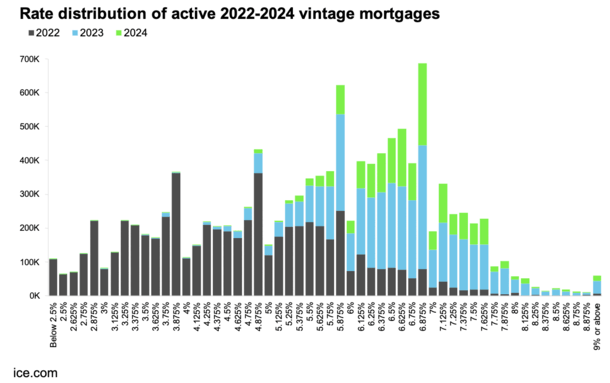Need to hear some excellent news about mortgage charges that includes them being quite a bit larger than they beforehand have been?
Sure, I do know that sounds absurd, however hear me out. There at the moment are thousands and thousands extra mortgages that function charges above 6.5%, and plenty of with charges above 7%.
There are additionally thousands and thousands much less that function charges under 5% than there have been only a couple years in the past.
Why is that this good you ask? Nicely, it means the results of mortgage price lock-in are starting to wane.
It additionally means thousands and thousands of debtors may stand to learn from a refinance as charges finally drop.
Almost a Quarter of Mortgage Holders Have an Curiosity Fee Above 5%
The newest Mortgage Monitor report from ICE launched this week discovered that there’s been fairly a shift in excellent mortgage charges.
Whereas it was fairly widespread for a house owner to carry a 30-year fastened priced at 2-3% a number of years in the past, it’s changing into much less so right this moment.
In reality, as of Could some 24% of these with excellent house loans had a mortgage price at or above 5%, up from simply 10% two years in the past.
On the identical time, there have been there practically six million (5.8M) fewer mortgages with charges under 5% than there have been there again then.
And practically 5 million (4.8M) fewer with charges under 4%, because of debtors both promoting their houses or in some instances pursuing a money out refinance.
Whereas the low-rate householders shed their mortgages through house sale or refinance, a brand new batch of high-rate householders is starting to take their place.
Since 2022, 4 million new 30-year fastened mortgages have been originated with charges above 6.5%, and of these roughly half (1.9M) have charges north of seven%.
In different phrases, the collective excellent mortgage price of all householders is rising.
This implies it’s changing into much less regular to have an ultra-low rate of interest and that might imply fewer roadblocks in relation to promoting and rising for-sale stock.
Why Is This Good Precisely?
In a nutshell, the shift from free financial coverage to tight Fed coverage within the matter of only a 12 months and alter wreaked havoc on mortgage charges and the housing market.
We went from 3% 30-year fastened mortgage charges in early 2022 to a price above 8% by late 2023.
Whereas the Fed doesn’t management mortgage charges, they made a giant splash after asserting an finish to their mortgage-backed securities (MBS) shopping for program generally known as Quantitative Easing (QE).
That meant the Fed was not a purchaser of mortgages, which instantly lowered their worth and raised the rate of interest demanded by different buyers to purchase them.
On the identical time, the Fed raised its personal fed funds price 11 occasions from near-zero to a goal vary of 5.25% to five.50%.
Whereas this was arguably vital to chill off demand within the too-hot housing market, it created a bunch of haves and have nots.
The householders with 2-4% mortgages fastened for the following 30 years, and renters dealing with exorbitant asking costs and 7-8% mortgage charges.
This dichotomy isn’t good for the housing market. It doesn’t enable folks to maneuver up or transfer down, or for brand new entrants to get into the market.
Because of the fast divergence in charges for the haves and have nots, house gross sales have plummeted.
The identical is true of refinances, particularly price and time period refis, hurting plenty of banks and mortgage lenders within the course of.
However as the common excellent mortgage price climbs larger, there will likely be much more exercise in the actual property and mortgage markets.
Right here Comes the Refis (Nicely, Not Simply But…)

If you happen to have a look at the chart above, you’ll see that latest vintages of mortgages have been dominated by high-rate mortgages.
The distribution of house loans with mortgage charges above 6% surged in 2023 and 2024 because the 30-year fastened ascended to its highest ranges in a long time.
Whereas this has clearly dampened housing affordability, and led to quite a few mortgage layoffs, it’s probably going to be a cyclical problem that improves annually.
Over time, the low-rate mortgages will likely be changed by higher-rate loans. And if mortgage charges average as inflation cools, many thousands and thousands will likely be within the cash a for a refinance.
So apart from mortgage price lock-in easing and extra houses coming to market, which pays off the underlying loans, we’ll additionally see extra refinance exercise as latest house consumers reap the benefits of decrease charges.
In reality, we’ve already seen it because the 30-year fastened is roughly 1% under its October 2023 peak, thanks partially to normalizing mortgage spreads.
Those that timed their house buy badly (by way of that mortgage price peak) have already been in a position to refinance right into a decrease month-to-month cost.
And if charges proceed to come back down this 12 months and subsequent, as is extensively anticipated, we’re going to see much more debtors refinance their mortgages.
It will profit these householders and the mortgage business, which historically depends upon refinances to maintain up quantity.
So whereas occasions have been bleak these final couple years, it’s all a part of the method.
The shift out of low cost cash and again into actuality ought to get issues shifting once more, whether or not it’s an uptick in house gross sales, mortgage lending, or each.
